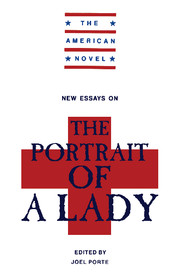Book contents
- Frontmatter
- Contents
- Series Editor's Preface
- A Note on the Text
- 1 Introduction: The Portrait of a Lady and “Felt Life”
- 2 The Portrait of a Lady and Modern Narrative
- 3 The Fatherless Heroine and the Filial Son: Deep Background for The Portrait of a Lady
- 4 The Portrait of a Lack
- 5 Frail Vessels and Vast Designs: A Psychoanalytic Portrait of Isabel Archer
- Notes on Contributors
- Selected Bibliography
4 - The Portrait of a Lack
Published online by Cambridge University Press: 04 August 2010
- Frontmatter
- Contents
- Series Editor's Preface
- A Note on the Text
- 1 Introduction: The Portrait of a Lady and “Felt Life”
- 2 The Portrait of a Lady and Modern Narrative
- 3 The Fatherless Heroine and the Filial Son: Deep Background for The Portrait of a Lady
- 4 The Portrait of a Lack
- 5 Frail Vessels and Vast Designs: A Psychoanalytic Portrait of Isabel Archer
- Notes on Contributors
- Selected Bibliography
Summary
… and indeed [I] have a strong impression that I didn't at any moment quite know what I was writing about: I am sure I couldn't otherwise have written so much.
–Henry JamesDESPITE the evident fact that he was a male child in a family of seven Jameses, young Henry found the truest representation of his self in the figures of the orphan and the woman. Both figures respond to the threat of extirpation that James felt menacing him from within his home and throughout his society. As a defense against and a compensation for his situation, James engaged in a recurring fantasy which he recognized as a child, deployed as a novelist, and discussed in his autobiography. In order to explain how this core fantasy and its attendant anxieties helped shape his first major masterpiece, The Portrait of a Lady, I will begin with the autobiographical volumes, A Small Boy and Others and Notes of a Son and Brother. Here James sets forth three of the most important things represented in The Portrait - the negating threat of transience and mortality, the realization that men as well as women are marked by emasculation and lack, and the Jamesian defenses against and compensations for such a situation. Taken together, the autobiography and The Portrait help reflect James's precarious but tenacious sense of himself, for in each text he both manifests his sense of negativity as the prime sign of the human condition and defines a fantasy to deal with a sense of lack so endemic.
Core Fantasy: Defense and Compensation A Small Boy reveals James's indulgence in what Freud would call Family Romance.
- Type
- Chapter
- Information
- New Essays on 'The Portrait of a Lady' , pp. 95 - 122Publisher: Cambridge University PressPrint publication year: 1990
- 5
- Cited by

